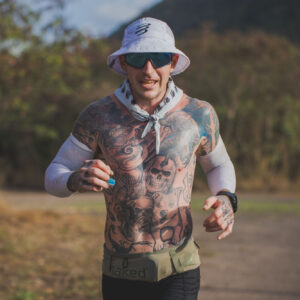Grand Teton 100–When everything goes right does not mean it’s a breeze….
The Grand Teton 100: Four laps of three sections, just around eight hours a lap, that’s 32 hours and it’s done. So what’s stopping you?
map and profile: http://www.dreamchaserevents.com/gtr/gtr_maps.htm
course description: http://www.dreamchaserevents.com/gtr/gtr_descriptions.htm
results: http://www.grandtetonraces.com/results.php?d=100
Well bud, looking up the 2780 feet of Fred’s Mountain I had an early idea, in fact I had more than an idea I had a justified dread of Fred’s – which would grow as the hours ticked by over the day and night—but that’s the story and it can wait.
Fred’s will become famous, even if Fred himself has fallen into obscurity. Fred’s– reaching up above 10 thousand feet, overlooking the rocky crags of the Grand Teton to the east and the long beautiful Teton Valley to the west. Fred’s with an excuse for a four wheeler road that is covered in shaley rock and small boulders, where at its steepest points one looks for foot holds in the mass of loose sliding rock. Fred’s where hyperventilation becomes the norm and just survival, Fred’s where at its easiest the distance to rise is one to one and at it’s worst damn near a hand hold climb. You got the idea? Climb Fred’s and near the top at over ten thousand feet you will get it one way or the other.
If you want to taste Fred’s in Hawaii you have to go to the trails of Mauna Kea, where the Hawaiian goddesses of the White Mountain give Fred a bottle and put him to bed at night. I climbed Fred’s four times and hurt, but I’d been up the Mauna Kea trail, and knew it could get so much worse– but that did not make it any less painful. Fred’s may be the Big Island Sister’s very small sibling, but it’s a mean ass climb none-the-less.
You get to the top of Fred’s Mountain coughing and gagging and grab a bit to eat and drink and then look out over the astounding beauty of the place. It is awesome in the most essential concept of the word. The grand Teton is a giant out-thrust of rock that reaches 12 to 13 thousand feet and sits surrounded by lesser crags and peaks that run along a giant spine of granite. It is another one of those special places in our grand country.
But, a word to the wise–visit the top of Fred’s before the race when you can take some time to enjoy the views and let the beauty settle into your soul. Buy a lift ticket and scope out the course from the top. Get a feeling for place early on. If you don’t you just won’t have the time or the mental aptitude to appreciate where you are, as you will either be so wacked out by the climb or too engrowsed in hesitantly looking down the steep you just came up–wondering how you are going to get down without jamming your knees all the way up and into your eye ball—to really enjoy the top of Fred’s.
So, it is slow and easy down, sliding and stumbling on the shale and rock that runs loose over the rough track, caution bells jangling in the back of your mind every time you slip, slide, or start to loose control. It’s a back wrenching down and one that only the fittest can do at any pace—though many seem to feel obligated to push in the earliest loops.
I made it up and down Fred’s between one hour and forty five and two hours each time I did the trek. I figured an even two for the out and back section. Hitting the bottom and the main aid station one has to keep in mind that the next loop is the longest and demands some preparation. I always loaded up with water and food before heading out on the Mill Creek loop. Don’t let the name fool you. It is almost as harsh a section as Fred’s and significantly longer– and many people I talked to felt it was the worst section of the run. Once again it starts with a long section of shaley track which is interspersed with a short single track trail that reunites with the track as it winds down into the Mill Creek Valley. Nasty stuff going down, very nasty, and if you are planning on doing a number of laps it demands a great deal of respect. There is a long section of very steep track that falls off the lip of the ridge and cascades down into the valley. It is almost as bad as Fred’s in many ways though not as long. Once that is behind you there are long winding miles of single track trails that move up and down the slopes of the valley and wind down toward the bottom land of Mill Creek. It’s a long trek and often quite technical, but the trails along the sides of the valley are heavily wooded and a joy to run.
Once you make it down to the bottom of the Valley you find yourself on an unpaved hard gravel road for a mile or so before reaching the bottom aid station, the only other drop bag station besides the main station at the Targee Resort. From the bottom aid station the runner moves onto Ski Hill road and begins a 3.5 mile climb along the paved road to the fifth aid station. The road is steep with a number of switchbacks and reminiscent of the long sections of the Haleakela crater road. There are some nice views, and traffic was fairly light so it was not nasty. At night I made this section with my lights out as the moon had risen making it an easy ‘dark’ run.
Once climbing up to the fifth aid station the runner returns to the trails and climbs up and around the hills that makes up the western sides of the mill creek valley. It’s a lot of up, and like climbing out of Nu’uanu in many ways, or going up Kuliouou. Finally this track rejoins the trail that you descended into the valley on and makes a run toward the back of Mill Creek Valley. At the back those downs that had you steeping cautiously down are suddenly very intimidating ups—Concretes times two with a lot of rubble in the way. This section was many a racer’s demise. The altitude gain is significant from the bottom of Mill Creek and the approximate eight miles culminates in some really mean and nasty track that just won’t let you out of the valley. It is a head down climb, an exercise in heavy breathing, and a ‘don’t stop or rest’ kind of place. I passed a lot of beat up runners on this section, and used it to bury many close following competitors.
Making it out of Mill Creek there is another quarter mile of climb along a track that is almost a dirt road. Then the trail dives down toward the Resort, and it is back to back- pedaling and watching one’s steps down the loose shale and rock or the track. I crabbed, and groucho’d a lot of the way but mostly just had to take it slow on the downs.
You make it back to the main station with twenty miles under your belt and only Rick’s Basin ahead. Once again the work road tracks are used to access the back trails and take you out to the edge of the Basin— more rough loose rocky ground. Once in the basin the trails are primarily winter cross country ski tracks and quite runable. There is a few hundred feet of elevation gain and this can come sudden and hard, but after John’s and Mill Creek, it is nothing to comment on. Looking out on Ricks one is struck by the beauty of the place. Distant Aspen groves, on the edge of yellowing, and groups of pines hug the sides of the bowl and a lush marshy area fills the very bottom. The middle three miles of Rick’s is a nice transition from the hard terrain of the first twenty-one miles, and it is not until the last mile or so when one has to climb out of the basin that the hilly nature of the basin once again begins to grab at your chest and remind you that this is trail running all above eight thousand feet.
So up and over the ridge and down the rough road and into the grassy area at the foot of the chair lift and you are done with the twenty five miles of the loop of the Grand Teton. I found a HURT pace to be very appropriate and was constantly comparing my progress to my HURT ideal time schedule. It seemed to work well. I was very slow at the start when compared to other runners, but I kept going where they fell out or lay in the chairs at the aid stations. Planning and fear of collapse were always at the back of my mind. It wasn’t until after mile 75 that I began to actually race other runners—and then the desire to pass was usually mixed with concern for people who were obviously overextended and hurting. Hydration and electrolytes were a key factor in the race. I found a lot of runners ignored the need to drink and keep electrolytes in balance. I passed them in the aid stations or wandering disoriented out on the trails. Nasty place to bonk in the hills.
I surprised myself and finished in 31:11 and took the male 50-60 age group. I felt good all the way, and had very little soreness the next day. Weight loss was minimal, and I was not unreasonably tired in the days following. I had some rather severe depression the night following the finish and got to wondering about the sanity of this venture. But by the next day it had passed and I had once again convinced myself that the complete insanity of what I am doing is no excuse for stopping.
Please pardon the egocentric nature of this post. There were lots of other runners out there and some other HURT veterans were on course. But I ran this one almost alone and the race was four of the loops I described with little interaction or variation. It was just a head down, hard ass push from beginning to end— no time to wonder why…Whoppie we’re all gonna die!
I recommend this course to seasoned runners who are seeking to enjoy a nice late summer vacation in the Teton. In the best of weather this is a wonderful experience much like what I enjoyed. In the worst of times I hear that 36 hours is a minimum as it can get very cold and wet instantly. Warm gear is a must, even if you don’t use it. Good hard soled trail shoes are a must. Altitude training would be very helpful—a few times up and down the Mauna Kea trail would be great training.
The volunteers were very kind and helpful. When I finished I was surrounded by a half dozen concerned young women, who insisted on hugging me and giving me kisses—I keep trying to convince myself this was not a hallucination. All during the race people were helpful and concerned. The food was good and I didn’t need much else. I have friends here and they came up to see me and bring me some luxuries. If the opportunity presented itself I’d come back again to face Fred’s mountain. Thanks to the Lisa and her crews.
I am now the proud possessor of one gigantic Teton 100 finisher buckle.
Much aloha to all of you. Mike M.

